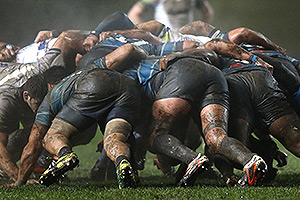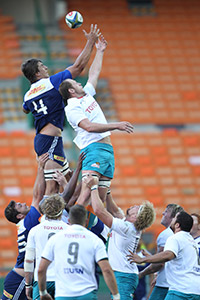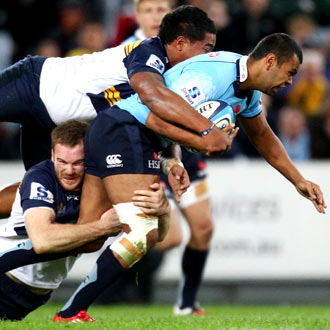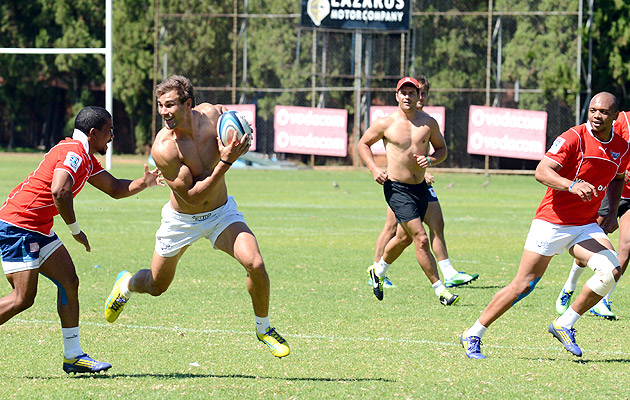Bray: 'Coaches driving attitude to laws'
SANZAR Game Manager and referees boss Lyndon Bray said coaches were driving the attitude to the laws and the application of the laws.
Bray, in a telconference on Wednesday, said he Super Rugby saw as the 'high octane' game and also explained the role of referees in it.
Bray spoke to aspects of the way the game could be played to ensure its place as the 'best rugby competition in the world'. Then he was open to questions. It proved an excellent exercise.
Several times Bray stressed that it was the coaches of the 15 franchises which were driving the attitude to the laws and the application of the laws in trying to maintain and develop the continuity and excitement that were characteristic of Super Rugby, giving star players, including some of the best in the world, an environment in which they could excel.
The coaches had agreed on four key-focus areas:
* scrum
* line-out and maul
* tackle/ruck
* space.
It was in applying the law to these forcus areas that referees were to seek the vital balance between continuity and contest – the confidence of the team in possession to keep playing with possession and the right of the defending team to contest for possession, for many of the best Super Rugby tries come from turnovers. But the team with possession should have the contest to play with possession in their own half, which has led to a great reduction in the amount of kicking, from some 70-80 kicks in a match to 40-45. This has greatly improved the game as a spectacle.
 1. The scrum
1. The scrum
In the setting of the scrum the referees were to look for a clear gap on the bind without the possibility of contact head-on-head. Then there was to be a proper engagement followed by stability before the ball was put in. Front rows were to push straight.
The wheel was allowed but tightheads were not allowed to pull back to get the scrum turning on its axis.
The ball was to be put into the middle of the scrum and the team putting the ball in was required either to hook the ball or push over it.
At collapsed scrums and when the front rows pushed up, the referee was allowed to let play go on if it happened immediately. Otherwise the referee was to intervene.
The standing up of front-row players is not a penalisable offence.
Bray praised the work of Balie Swart in improving scumming and the delivery from scrums in Super Rugby matches.
 2. Line-out
2. Line-out
It was important that 'crushing' was eliminated – where an opponent of the catcher in the line-out bears down on catcher while he is still in the air.
Secondly, cleaning out of the jumper's support was illegal.
Thirdly, side entry into the maul was to be penalised. This was often preceded by crabbing up the side of a maul, which was illegal.
In answer to a question on a team's refusal to form a maul, Bray said that this was baling out of the contest which was against the intent of the game. Referees had been told that if the team in possession formed up as for a maul but the other team stood off and the ball was worked back to their back man who was then tackled by an opponent, a scrum for accidental offside was to be awarded.
 3. Tackle/ruck
3. Tackle/ruck
The tackle/ruck was an aspect of the game intended to make the ball available at speed and at the same time to allow a contest for the ball.
The coaches had identified as a problem the actions of the 'tackler assist', a player who is part of the tackling but stays on his feet. He is required to allow a chance for the tackled player to play the ball by showing clear daylight before he played the ball, at times from the 'wrong' side. The coaches were unanimous on the need for firmer action in dealing with the tackler assist.
If a ruck collapsed, no player was allowed to step over the players on the ground to play the ball. The player whose team is winning the ball is to be allowed time to clear it.
This did not apply at a tackle which did not become a ruck.
A player on the ground who is trying to get away from obstructing the ball, must roll to the side and not back into the way of the scrumhalf/receiver.
 4. Space
4. Space
The coaches required better policing of the 5-metre offside line at scrums and the 10-metre offside line at line-outs.
At the ruck, the players on the sides, sometimes called pillars, are to be carefully watched. Coaches wanted the referees to be strong with the whistle rather than with management in this case.
In general terms, Brays said that the focus areas had not changed since first meeting with the coaches in 2009. This year, again, he had met all the coaches face to face and had collated the topics on which they had agreed.
There were times in the past when there had been a crackdown which lasted for only the first few weeks. This environment had changed and referees were aware of the need to apply the law throughout the whole tournament and that they would be held accountable for not doing so. The compliance of referees and teams would be monitored.
In addition to accountability, which the referees themselves want, SANZAR is to ensure that referees had the resources they needed to referee. This would be even more important next year when the expanded Super Rugby would require more referees.
Asked about having unattached/neutral referees, Bray said that unanimously the coaches wanted the best referees to be appointed and that ability not be sacrificed for 'neutrality'. In fact the expanded competition in 2016 would make neutrality extremely difficult, if not impossible.
Bray would like the TMO used sparingly and not at all when the referee is confident of his decision. He said that there were problems in first nine weeks of 2014, mostly because of referee error in dealing with the TMO but improving communication had improved matters.
Asked if the TMO could alert referees to an unseen incident which may have led to a head knock and possible concussion, as was the case with George North when Wales played England, Bray said he would welcome such an addition to the TMO protocol.
It is intended that similar such telephone conferences would be used in the future.
By Paul Dobson
@rugby365com















































